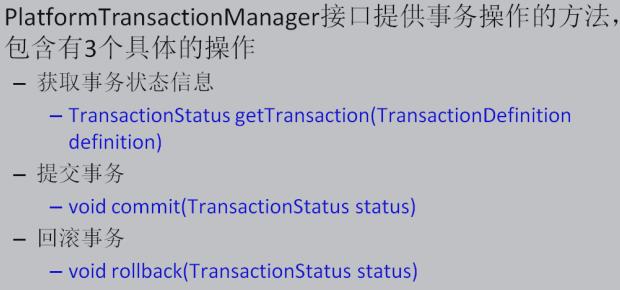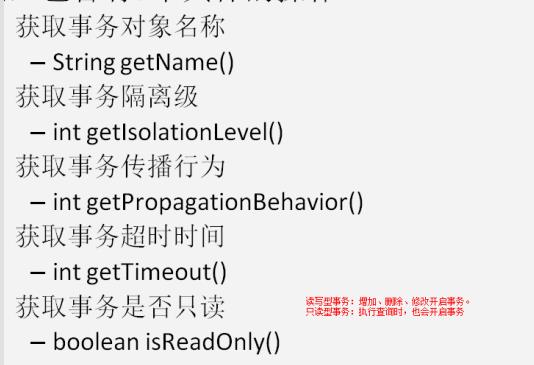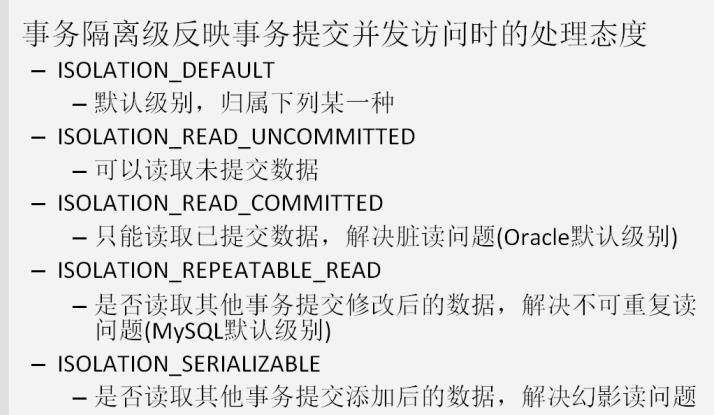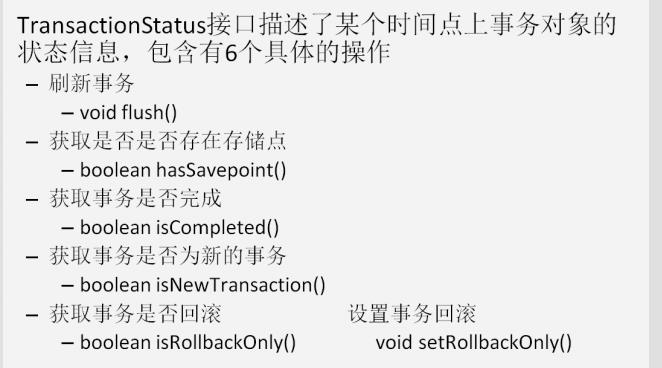spring
Posted m0_56426304
tags:
篇首语:本文由小常识网(cha138.com)小编为大家整理,主要介绍了spring相关的知识,希望对你有一定的参考价值。
Spring 中的 JdbcTemplate
JdbcTemplate的作用:它就是用于和数据库交互的,实现对表的CRUD操作
JdbcTemplate 对象的创建
我们可以参考它的源码,来一探究竟:public JdbcTemplate()
public JdbcTemplate(DataSource dataSource)
setDataSource(dataSource);
afterPropertiesSet();
public JdbcTemplate(DataSource dataSource, boolean lazyInit)
setDataSource(dataSource);
setLazyInit(lazyInit);
afterPropertiesSet();
spring 中配置数据源
环境搭建编写 spring 的配置文件
<?xml version="1.0" encoding="UTF-8"?>
<beans xmlns="http://www.springframework.org/schema/beans"
xmlns:xsi="http://www.w3.org/2001/XMLSchema-instance"
xsi:schemaLocation="http://www.springframework.org/schema/beans
http://www.springframework.org/schema/beans/spring-beans.xsd">
</beans>配置数据源
C3P0 和 DBCP, 要想使用这两数据源都需要导入对应的 jar 包 配置 C3P0 数据源 导入 到工程的
lib
目录,在
spring
的配置文件中配置:
到工程的
lib
目录,在
spring
的配置文件中配置:
<bean id="dataSource" class="com.mchange.v2.c3p0.ComboPooledDataSource">
<property name="driverClass" value="com.mysql.jdbc.Driver"></property>
<property name="jdbcUrl" value="jdbc:mysql:///spring_day02"></property> <property name="user" value="root"></property>
<property name="password" value="1234"></property>
</bean> 到工程的
lib
目录,在
spring
的配置文件中配置:
到工程的
lib
目录,在
spring
的配置文件中配置:
<!-- 配置数据源 -->
<bean id="dataSource" class="org.apache.commons.dbcp.BasicDataSource">
<property name="driverClassName" value="com.mysql.jdbc.Driver"></property>
<property name="url" value="jdbc:mysql:// /spring_day02"></property>
<property name="username" value="root"></property>
<property name="password" value="1234"></property>
</bean><bean
id="dataSource"
class="org.springframework.jdbc.datasource.DriverManagerDataSource">
<property name="driverClassName" value="com.mysql.jdbc.Driver"></property>
<property name="url" value="jdbc:mysql:///spring_day02"></property>
<property name="username" value="root"></property>
<property name="password" value="1234"></property>
</bean><!-- 引入外部属性文件: -->
<bean
class="org.springframework.beans.factory.config.PropertyPlaceholderConfigurer">
<property name="location" value="classpath:jdbc.properties"/>
</bean><context:property-placeholder location="classpath:jdbc.properties"/>JdbcTemplate 的增删改查操作
前期准备
创建数据库:create database spring_day02;
use spring_day02;create table account(
id int primary key auto_increment,
name varchar(40),
money float
)character set utf8 collate utf8_general_ci;<?xml version="1.0" encoding="UTF-8"?>
<beans xmlns="http://www.springframework.org/schema/beans"
xmlns:xsi="http://www.w3.org/2001/XMLSchema-instance"
xsi:schemaLocation="http://www.springframework.org/schema/beans
http://www.springframework.org/schema/beans/spring-beans.xsd">
<!-- 配置一个数据库的操作模板:JdbcTemplate -->
<bean id="jdbcTemplate" class="org.springframework.jdbc.core.JdbcTemplate">
<property name="dataSource" ref="dataSource"></property>
</bean>
<!-- 配置数据源 -->
<bean
id="dataSource"
class="org.springframework.jdbc.datasource.DriverManagerDataSource">
<property name="driverClassName" value="com.mysql.jdbc.Driver"></property>
<property name="url" value="jdbc:mysql:///spring_day02"></property>
<property name="username" value="root"></property>
<property name="password" value="1234"></property>
</bean>
</beans>public class JdbcTemplateDemo2
public static void main(String[] args)
//1.获取 Spring 容器
ApplicationContext ac = new ClassPathXmlApplicationContext("bean.xml");
//2.根据 id 获取 bean 对象
JdbcTemplate jt = (JdbcTemplate) ac.getBean("jdbcTemplate");
//3.执行操作
jt.execute("insert into account(name,money)values('eee',500)");
public class JdbcTemplateDemo3
public static void main(String[] args)
//1.获取 Spring 容器
ApplicationContext ac = new ClassPathXmlApplicationContext("bean.xml");
//2.根据 id 获取 bean 对象
JdbcTemplate jt = (JdbcTemplate) ac.getBean("jdbcTemplate");
//3.执行操作
//保存
jt.update("insert into account(name,money)values(?,?)","fff",5000);
public class JdbcTemplateDemo3
public static void main(String[] args)
//1.获取 Spring 容器
ApplicationContext ac = new ClassPathXmlApplicationContext("bean.xml");
//2.根据 id 获取 bean 对象
JdbcTemplate jt = (JdbcTemplate) ac.getBean("jdbcTemplate");
//3.执行操作
//修改
jt.update("update account set money = money-? where id = ?",300,6);
public class JdbcTemplateDemo3
public static void main(String[] args)
//1.获取 Spring 容器
ApplicationContext ac = new ClassPathXmlApplicationContext("bean.xml");
//2.根据 id 获取 bean 对象
JdbcTemplate jt = (JdbcTemplate) ac.getBean("jdbcTemplate");
//3.执行操作
//删除
jt.update("delete from account where id = ?",6);
public class JdbcTemplateDemo3
public static void main(String[] args)
//1.获取 Spring 容器
ApplicationContext ac = new ClassPathXmlApplicationContext("bean.xml");
//2.根据 id 获取 bean 对象
JdbcTemplate jt = (JdbcTemplate) ac.getBean("jdbcTemplate");
//3.执行操作
//查询所有
List<Account> accounts = jt.query("select * from account where money > ? ",
new AccountRowMapper(), 500);
for(Account o : accounts)
System.out.println(o);
public class AccountRowMapper implements RowMapper<Account>
@Override
public Account mapRow(ResultSet rs, int rowNum) throws SQLException
Account account = new Account();
account.setId(rs.getInt("id"));
account.setName(rs.getString("name"));
account.setMoney(rs.getFloat("money"));
return account;
public class JdbcTemplateDemo3
public static void main(String[] args)
//1.获取 Spring 容器
ApplicationContext ac = new ClassPathXmlApplicationContext("bean.xml");
//2.根据 id 获取 bean 对象
JdbcTemplate jt = (JdbcTemplate) ac.getBean("jdbcTemplate");
//3.执行操作
//查询一个
List<Account> as = jt.query("select * from account where id = ? ",
new AccountRowMapper(), 55);
System.out.println(as.isEmpty()?"没有结果":as.get(0));
public class JdbcTemplateDemo3
public static void main(String[] args)
//1.获取 Spring 容器
ApplicationContext ac = new ClassPathXmlApplicationContext("bean.xml");
//2.根据 id 获取 bean 对象
JdbcTemplate jt = (JdbcTemplate) ac.getBean("jdbcTemplate");
//3.执行操作
//查询一个
Account account = jt.query("select * from account where id = ?",
new AccountResultSetExtractor(),3);
System.out.println(account);
public class JdbcTemplateDemo3
public static void main(String[] args)
//1.获取 Spring 容器
ApplicationContext ac = new ClassPathXmlApplicationContext("bean.xml");
//2.根据 id 获取 bean 对象
JdbcTemplate jt = (JdbcTemplate) ac.getBean("jdbcTemplate");
//3.执行操作
//查询返回一行一列:使用聚合函数,在不使用 group by 字句时,都是返回一行一列。最长用的
就是分页中获取总记录条数
Integer total = jt.queryForObject("select count(*) from account where money > ?
",Integer.class,500);
System.out.println(total);
在 dao 中使用 JdbcTemplate
准备实体类/**
* 账户的实体
*/
public class Account implements Serializable
private Integer id;
private String name;
private Float money;
public Integer getId()
return id;
public void setId(Integer id)
this.id = id;
public String getName()
return name;
public void setName(String name)
this.name = name;
public Float getMoney()
return money;
public void setMoney(Float money)
this.money = money;
@Override
public String toString()
return "Account [id=" + id + ", name=" + name + ", money=" + money + "]";
第一种方式 :在 dao 中定义 JdbcTemplate第二种方式 :让 dao 继承 JdbcDaoSupport JdbcDaoSupport 是 spring 框架为我们提供的一个类,该类中定义了一个 JdbcTemplate 对象,我们可以直接获取使用,但是要想创建该对象,需要为其提供一个数据源:具体源码如下:/** * 账户的接口 */ public interface IAccountDao /** * 根据 id 查询账户信息 * @param id * @return */ Account findAccountById(Integer id); /** * 根据名称查询账户信息 * @return */ Account findAccountByName(String name); /** * 更新账户信息 * @param account */ void updateAccount(Account account); /** * 账户的持久层实现类 * 此版本的 dao,需要给 dao 注入 JdbcTemplate */ public class AccountDaoImpl implements IAccountDao private JdbcTemplate jdbcTemplate; public void setJdbcTemplate(JdbcTemplate jdbcTemplate) this.jdbcTemplate = jdbcTemplate; @Override public Account findAccountById(Integer id) List<Account> list = jdbcTemplate.query("select * from account where id = ? ",new AccountRowMapper(),id); return list.isEmpty()?null:list.get(0); @Override public Account findAccountByName(String name) List<Account> list = jdbcTemplate.query("select * from account where name = ? ",new AccountRowMapper(),name); if(list.isEmpty()) return null; if(list.size()>1) throw new RuntimeException("结果集不唯一,不是只有一个账户对象"); return list.get(0); @Override public void updateAccount(Account account) jdbcTemplate.update("update account set money = ? where id = ? ",account.getMoney(),account.getId());配置文件
<?xml version="1.0" encoding="UTF-8"?> <beans xmlns="http://www.springframework.org/schema/beans" xmlns:xsi="http://www.w3.org/2001/XMLSchema-instance" xsi:schemaLocation="http://www.springframework.org/schema/beans http://www.springframework.org/schema/beans/spring-beans.xsd"> <!-- 配置一个 dao --> <bean id="accountDao" class="com.itheima.dao.impl.AccountDaoImpl"> <!-- 注入 jdbcTemplate --> <property name="jdbcTemplate" ref="jdbcTemplate"></property> </bean> <!-- 配置一个数据库的操作模板:JdbcTemplate --> <bean id="jdbcTemplate" class="org.springframework.jdbc.core.JdbcTemplate"> <property name="dataSource" ref="dataSource"></property> </bean> <!-- 配置数据源 --> <bean id="dataSource" class="org.springframework.jdbc.datasource.DriverManagerDataSource"> <property name="driverClassName" value="com.mysql.jdbc.Driver"></property> <property name="url" value="jdbc:mysql:///spring_day04"></property> <property name="username" value="root"></property> <property name="password" value="1234"></property> </bean> </beans>
public abstract class JdbcDaoSupport extends DaoSupport
//定义对象
private JdbcTemplate jdbcTemplate;
//set 方法注入数据源,判断是否注入了,注入了就创建 JdbcTemplate
public final void setDataSource(DataSource dataSource)
if (this.jdbcTemplate == null || dataSource != this.jdbcTemplate.getDataSource())
//如果提供了数据源就创建 JdbcTemplate
this.jdbcTemplate = createJdbcTemplate(dataSource);
initTemplateConfig();
//使用数据源创建 JdcbTemplate
protected JdbcTemplate createJdbcTemplate(DataSource dataSource)
return new JdbcTemplate(dataSource);
//当然,我们也可以通过注入 JdbcTemplate 对象
public final void setJdbcTemplate(JdbcTemplate jdbcTemplate)
this.jdbcTemplate = jdbcTemplate;
initTemplateConfig();
//使用 getJdbcTmeplate 方法获取操作模板对象
public final JdbcTemplate getJdbcTemplate()
return this.jdbcTemplate;
/**
* 账户的接口
*/
public interface IAccountDao
/**
* 根据 id 查询账户信息
* @param id
* @return
*/
Account findAccountById(Integer id);
/**
* 根据名称查询账户信息
* @return
*/
Account findAccountByName(String name);
/**
* 更新账户信息
* @param account
*/
void updateAccount(Account account);
/**
* 账户的持久层实现类
* 此版本 dao,只需要给它的父类注入一个数据源
*/
public class AccountDaoImpl2 extends JdbcDaoSupport implements IAccountDao
@Override
public Account findAccountById(Integer id)
//getJdbcTemplate()方法是从父类上继承下来的。
List<Account> list = getJdbcTemplate().query("select * from account where
id = ? ",new AccountRowMapper(),id);
return list.isEmpty()?null:list.get(0);
@Override
public Account findAccountByName(String name)
//getJdbcTemplate()方法是从父类上继承下来的。
List<Account> list = getJdbcTemplate().query("select * from account where
name = ? ",new AccountRowMapper(),name);
if(list.isEmpty())
return null;
if(list.size()>1)
throw new RuntimeException("结果集不唯一,不是只有一个账户对象");
return list.get(0);
@Override
public void updateAccount(Account account)
//getJdbcTemplate()方法是从父类上继承下来的。
getJdbcTemplate().update("update account set money = ? where id = ?
",account.getMoney(),account.getId());
<?xml version="1.0" encoding="UTF-8"?>
<beans xmlns="http://www.springframework.org/schema/beans"
xmlns:xsi="http://www.w3.org/2001/XMLSchema-instance"
xsi:schemaLocation="http://www.springframework.org/schema/beans
http://www.springframework.org/schema/beans/spring-beans.xsd">
<!-- 配置 dao2 -->
<bean id="accountDao2" class="com.itheima.dao.impl.AccountDaoImpl2">
<!-- 注入 dataSource -->
<property name="dataSource" ref="dataSource"></property>
</bean>
<!-- 配置数据源 -->
<bean
id="dataSource"
class="org.springframework.jdbc.datasource.DriverManagerDataSource">
<property name="driverClassName" value="com.mysql.jdbc.Driver"></property>
<property name="url" value="jdbc:mysql:///spring_day04"></property>
<property name="username" value="root"></property>
<property name="password" value="1234"></property>
</bean>
</beans>spring中的事务控制
Spring 中事务控制的 API 介绍
PlatformTransactionManager
此接口是 spring 的事务管理器,它里面提供了我们常用的操作事务的方法,如下图: 我们在开发中都是使用它的实现类,如下图
我们在开发中都是使用它的实现类,如下图
真正管理事务的对象 org.springframework.jdbc.datasource. DataSourceTransactionManager 使用 Spring JDBC 或 iBatis 进行持久化数据时使用 org.springframework.orm.hibernate5. HibernateTransactionManager 使用 Hibernate 版本进行持久化数据时使用
TransactionDefinition
它是事务的定义信息对象,里面有如下方法:
事务的隔离级别

事务的传播行为
REQUIRED: 如果当前没有事务,就新建一个事务,如果已经存在一个事务中,加入到这个事务中。一般的选择(默认值) SUPPORTS: 支持当前事务,如果当前没有事务,就以非事务方式执行(没有事务) MANDATORY :使用当前的事务,如果当前没有事务,就抛出异常 REQUERS_NEW: 新建事务,如果当前在事务中,把当前事务挂起。 NOT_SUPPORTED: 以非事务方式执行操作,如果当前存在事务,就把当前事务挂起 NEVER: 以非事务方式运行,如果当前存在事务,抛出异常 NESTED: 如果当前存在事务,则在嵌套事务内执行。如果当前没有事务,则执行 REQUIRED 类似的操作超时时间 默认值是 -1 ,没有超时限制。如果有,以秒为单位进行设置。 是否是只读事务 建议查询时设置为只读
TransactionStatus
此接口提供的是事务具体的运行状态,方法介绍如下图:
基于 XML 的声明式事务控制(配置方式)重点
环境搭建
第一步:拷贝必要的 jar 包到工程的 lib 目录 第二步:创建 spring 的配置文件并导入约束 此处需要导入 aop 和 tx 两个名称空间<?xml version="1.0" encoding="UTF-8"?>
<beans xmlns="http://www.springframework.org/schema/beans"
xmlns:xsi="http://www.w3.org/2001/XMLSchema-instance"
xmlns:aop="http://www.springframework.org/schema/aop"
xmlns:tx="http://www.springframework.org/schema/tx"
xsi:schemaLocation="http://www.springframework.org/schema/beans
http://www.springframework.org/schema/beans/spring-beans.xsd
http://www.springframework.org/schema/tx
http://www.springframework.org/schema/tx/spring-tx.xsd
http://www.springframework.org/schema/aop
http://www.springframework.org/schema/aop/spring-aop.xsd">
</beans>create database spring_day04;
use spring_day04;create table account(
id int primary key auto_increment,
name varchar(40),
money float
)character set utf8 collate utf8_general_ci;/**
* 账户的实体
*/
public class Account implements Serializable
private Integer id;
private String name;
private Float money;
public Integer getId()
return id;
public void setId(Integer id)
this.id = id;
public String getName()
return name;
public void setName(String name)
this.name = name;
public Float getMoney()
return money;
public void setMoney(Float money)
this.money = money;
@Override
public String toString()
return "Account [id=" + id + ", name=" + name + ", money=" + money + "]";
/**
* 账户的业务层接口
*/
public interface IAccountService
/**
* 根据 id 查询账户信息
* @param id
* @return
*/
Account findAccountById(Integer id);//查
/**
* 转账
* @param sourceName
转出账户名称
* @param targeName
转入账户名称
* @param money
转账金额
*/
void transfer(String sourceName,String targeName,Float money);//增删改
/**
* 账户的业务层实现类
*/
public class AccountServiceImpl implements IAccountService
private IAccountDao accountDao;
public void setAccountDao(IAccountDao accountDao)
this.accountDao = accountDao;
@Override
public Account findAccountById(Integer id)
return accountDao.findAccountById(id);
@Override
public void transfer(String sourceName, String targeName, Float money)
//1.根据名称查询两个账户
Account source = accountDao.findAccountByName(sourceName);
Account target = accountDao.findAccountByName(targeName);
//2.修改两个账户的金额
source.setMoney(source.getMoney()-money);//转出账户减钱
target.setMoney(target.getMoney()+money);//转入账户加钱
//3.更新两个账户
accountDao.updateAccount(source);
int i=1/0;
accountDao.updateAccount(target);
/**
* 账户的持久层接口
*/
public interface IAccountDao
/**
* 根据 id 查询账户信息
* @param id
* @return
*/
Account findAccountById(Integer id);
/**
* 根据名称查询账户信息
* @return
*/
Account findAccountByName(String name);
/**
* 更新账户信息
* @param account
*/
void updateAccount(Account account);
/**
* 账户的持久层实现类
* 此版本 dao,只需要给它的父类注入一个数据源
*/
public class AccountDaoImpl extends JdbcDaoSupport implements IAccountDao
@Override
public Account findAccountById(Integer id)
List<Account> list = getJdbcTemplate().query("select * from account where
id = ? ",new AccountRowMapper(),id);
return list.isEmpty()?null:list.get(0);
@Override
public Account findAccountByName(String name)
List<Account> list = getJdbcTemplate().query("select * from account where
name = ? ",new AccountRowMapper(),name);
if(list.isEmpty())
return null;
if(list.size()>1)
throw new RuntimeException("结果集不唯一,不是只有一个账户对象");
return list.get(0);
@Override
public void updateAccount(Account account)
getJdbcTemplate().update("update account set money = ? where id = ?
",account.getMoney(),account.getId());
/**
* 账户的封装类 RowMapper 的实现类
*/
public class AccountRowMapper implements RowMapper<Account>
@Override
public Account mapRow(ResultSet rs, int rowNum) throws SQLException
Account account = new Account();
account.setId(rs.getInt("id"));
account.setName(rs.getString("name"));
account.setMoney(rs.getFloat("money"));
return account;
<!-- 配置 service -->
<bean id="accountService" class="com.itheima.service.impl.AccountServiceImpl">
<property name="accountDao" ref="accountDao"></property>
</bean>
<!-- 配置 dao -->
<bean id="accountDao" class="com.itheima.dao.impl.AccountDaoImpl">
<!-- 注入 dataSource -->
<property name="dataSource" ref="dataSource"></property>
</bean>
<!-- 配置数据源 -->
<bean
id="dataSource"
class="org.springframework.jdbc.datasource.DriverManagerDataSource">
<property name="driverClassName" value="com.mysql.jdbc.Driver"></property>
<property name="url" value="jdbc:mysql:///spring_day04"></property>
<property name="username" value="root"></property>
<property name="password" value="1234"></property>
</bean>配置步骤
第一步:配置事务管理器<!-- 配置一个事务管理器 -->
<bean
id="transactionManager"
class="org.springframework.jdbc.datasource.DataSourceTransactionManager">
<!-- 注入 DataSource -->
<property name="dataSource" ref="dataSource"></property>
</bean><!-- 事务的配置 -->
<tx:advice id="txAdvice" transaction-manager="transactionManager">
</tx:advice>第三步:配置事务的属性属性:
id:给事务通知起一个唯一标识
transaction-manager:给事务通知提供一个事务管理器引用
<!--在 tx:advice 标签内部 配置事务的属性 -->
<tx:attributes>
<!-- 指定方法名称:是业务核心方法
read-only:是否是只读事务。默认 false,不只读。
isolation:指定事务的隔离级别。默认值是使用数据库的默认隔离级别。
propagation:指定事务的传播行为。
timeout:指定超时时间。默认值为:-1。永不超时。
rollback-for:用于指定一个异常,当执行产生该异常时,事务回滚。产生其他异常,事务不回滚。
没有默认值,任何异常都回滚。
no-rollback-for:用于指定一个异常,当产生该异常时,事务不回滚,产生其他异常时,事务回
滚。没有默认值,任何异常都回滚。
-->
<tx:method name="*" read-only="false" propagation="REQUIRED"/>
<tx:method name="find*" read-only="true" propagation="SUPPORTS"/>
</tx:attributes>第四步:配置 AOP 切入点表达式指定方法名称:是业务核心方法
read-only:是否是只读事务。默认 false,不只读。
isolation:指定事务的隔离级别。默认值是使用数据库的默认隔离级别。
propagation:指定事务的传播行为。
timeout:指定超时时间。默认值为:-1。永不超时。
rollback-for:用于指定一个异常,当执行产生该异常时,事务回滚。产生其他异常,事务不回滚。没有默认值,任何异常都回滚。
no-rollback-for:用于指定一个异常,当产生该异常时,事务不回滚,产生其他异常时,事务回滚,没有默认值,任何异常都回滚。
<!-- 配置 aop -->
<aop:config>
<!-- 配置切入点表达式 -->
<aop:pointcut
expression="execution(* com.itheima.service.impl.*.*(..))"
id="pt1"/>
</aop:config><!-- 在 aop:config 标签内部:建立事务的通知和切入点表达式的关系 -->
<aop:advisor advice-ref="txAdvice" pointcut-ref="pt1"/>基于注解的配置方式
环境搭建
第一步:拷贝必备的 jar 包到工程的 lib 目录 第二步:创建 spring 的配置文件导入约束并配置扫描的包<?xml version="1.0" encoding="UTF-8"?>
<beans xmlns="http://www.springframework.org/schema/beans"
xmlns:aop="http://www.springframework.org/schema/aop"
xmlns:tx="http://www.springframework.org/schema/tx"
xmlns:context="http://www.springframework.org/schema/context"
xmlns:xsi="http://www.w3.org/2001/XMLSchema-instance"
xsi:schemaLocation="
http://www.springframework.org/schema/beans
http://www.springframework.org/schema/beans/spring-beans.xsd
http://www.springframework.org/schema/aop
http://www.springframework.org/schema/aop/spring-aop.xsd
http://www.springframework.org/schema/tx
http://www.springframework.org/schema/tx/spring-tx.xsd
http://www.springframework.org/schema/context
http://www.springframework.org/schema/context/spring-context.xsd">
<!-- 配置 spring 创建容器时要扫描的包 -->
<context:component-scan base-package="com.itheima"></context:component-scan>
<!-- 配置 JdbcTemplate-->
<bean id="jdbcTemplate" class="org.springframework.jdbc.core.JdbcTemplate">
<property name="dataSource" ref="dataSource"></property>
</bean>
<!-- 配置 spring 提供的内置数据源 -->
<bean
id="dataSource"
class="org.springframework.jdbc.datasource.DriverManagerDataSource">
<property
name="driverClassName"
value="com.mysql.jdbc.Driver"></property>
<property
name="url"
value="jdbc:mysql://localhost:3306/spring_day02"></property>
<property name="username" value="root"></property>
<property name="password" value="1234"></property>
</bean>
</beans>/**
* 账户的业务层实现类
*/
@Service("accountService")
public class AccountServiceImpl implements IAccountService
@Autowired
private IAccountDao accountDao;
//其余代码和基于 XML 的配置相同
/**
* 账户的持久层实现类
*/
@Repository("accountDao")
public class AccountDaoImpl implements IAccountDao
@Autowired
private JdbcTemplate jdbcTemplate;
//其余代码和基于 XML 的配置相同
配置步骤
第一步:配置事务管理器并注入数据源<!-- 配置事务管理器 -->
<bean
id="transactionManager"
class="org.springframework.jdbc.datasource.DataSourceTransactionManager">
<property name="dataSource" ref="dataSource"></property>
</bean>@Service("accountService")
@Transactional(readOnly=true,propagation=Propagation.SUPPORTS)
public class AccountServiceImpl implements IAccountService
@Autowired
private IAccountDao accountDao;
@Override
public Account findAccountById(Integer id)
return accountDao.findAccountById(id);
@Override
@Transactional(readOnly=false,propagation=Propagation.REQUIRED)
public void transfer(String sourceName, String targeName, Float money)
//1.根据名称查询两个账户
Account source = accountDao.findAccountByName(sourceName);
Account target = accountDao.findAccountByName(targeName);
//2.修改两个账户的金额
source.setMoney(source.getMoney()-money);//转出账户减钱
target.setMoney(target.getMoney()+money);//转入账户加钱
//3.更新两个账户
accountDao.updateAccount(source);
//int i=1/0;
accountDao.updateAccount(target);传智播客——专注于 Java、.Net 和 php、网页平面设计工程师的培训
北京市昌平区建材城西路金燕龙办公楼一层 电话:400-618-9090
该注解的属性和 xml 中的属性含义一致。该注解可以出现在接口上,类上和方法上 出现接口上,表示该接口的所有实现类都有事务支持 出现在类上,表示类中所有方法有事务支持 出现在方法上,表示方法有事务支持 以上三个位置的 优先级:方法>类>接口第三步:在配置文件中开启 spring 对注解事务的支持
<!-- 开启 spring 对注解事务的支持 -->
<tx:annotation-driven transaction-manager="transactionManager"/>@Configuration
@EnableTransactionManagement
public class SpringTxConfiguration
//里面配置数据源,配置 JdbcTemplate,配置事务管理器。在之前的步骤已经写过了。
以上是关于spring的主要内容,如果未能解决你的问题,请参考以下文章